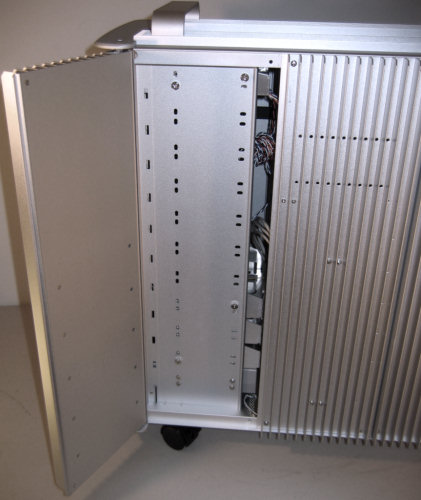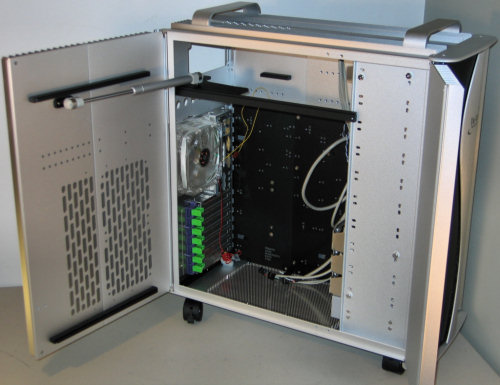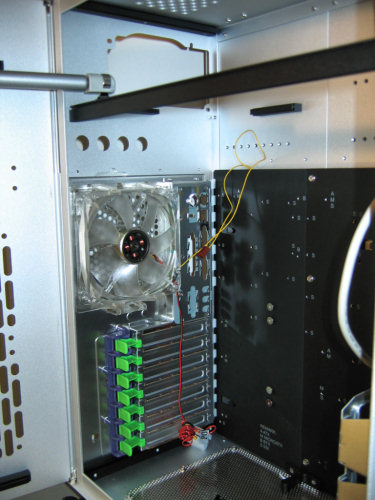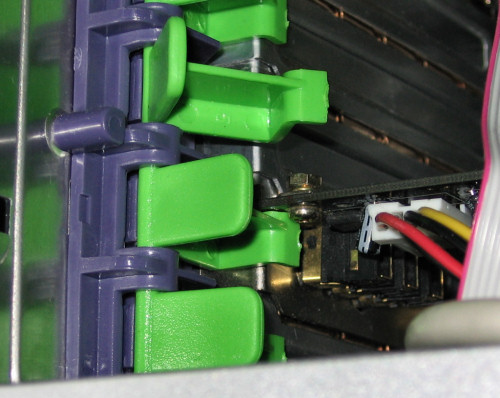Clash of the Titans - TT Tai Chi vs. CM Stacker 830
by Joshua Buss on February 23, 2006 12:05 AM EST- Posted in
- Cases/Cooling/PSUs
Thermaltake Tai Chi (cont’d)
To keep the case as tool-less as possible, Thermaltake simply chose to use thumbscrews to secure drives into the 5¼” bays. While this requires opening the right side of the chassis, there are a couple reasons why this isn't as much of a problem with the Tai Chi as it is with most cases.
First, this area of the case can open entirely on its own as shown in the picture above, which we found that it actually makes for an excellent place to hide additional cables, ensuring tidiness in the rest of the PC. More importantly, however, the Tai Chi's free-turning casters make turning the case a cinch, so access isn't as big of a deal. Two of the same large extended thumbscrews mentioned previously are used to hold this latch secure when closed.
The left side of the case is where the real attraction on the Tai Chi comes though. Here, a hydraulic arm is used to actively swing the oversized access door open, which simply consists of two of the solid passive vent-lined panels connected with the black solid aluminum bars visible in the above picture. The third panel on the left side opens as well, mirroring the panel on the right side that was just discussed.
This active opening mechanism has its own benefits and drawbacks; in using the case, the main advantage to this approach that we've found is that it stays fully open when working inside. Besides that, and the “wow factor“ of showing off the case, there's not much of a reason to incorporate the arm; especially if lots of equipment are installed to the inside of the door, a forceful opening might not be what the user desires. However, if preferred, the entire hydraulic assembly can be removed without hurting any other functionality.
The front of the case is exceptionally accessible, thanks to this dual-door design. Notice how there's another area here between the forward door and the drive bays (about one full inch in width) that could be used for any number of things. This picture is also a decent shot of the bottom mesh and motherboard tray, and also gives one an idea of how neatly they can route the cables from the top-mounted external ports, considering their plentiful length.
Focusing on the inside rear of the case, we find one of the only two main active cooling components, a Thermaltake 120mm blue LED fan. These fans move plenty of air without making enough noise to even really notice that they're on, especially if controlled to use slightly less voltage than the standard 12v.
The punch outs for 3/8” OD water tubing are also visible, as are the same tool-less expansion card locking mechanisms found on the Eclipse, which was recently reviewed by AnandTech. One frustration with this particular scheme is that they can be very difficult to unclip with certain cards. A SoundBlaster Audigy for instance made it darn-near impossible to unclip the green part in our test system due to a bolt on the card as seen here.
We'd prefer here if Thermaltake had simply opted for large thumbscrews like what other manufacturers are doing for the expansion cards. Take comfort though that this is pretty much the only complaint that we have with the Tai Chi after working with it for several days.
The spaces between the PSU area, crossbar, and motherboard assembly are all generous and, combined with the wide-opening dual doors, make working in the case a real pleasure. One last point of interest in this picture is the slots in the motherboard tray near the rear – they're not just at the bottom, indicating yet again that the case is truly designed and ready for BTX motherboards.
To keep the case as tool-less as possible, Thermaltake simply chose to use thumbscrews to secure drives into the 5¼” bays. While this requires opening the right side of the chassis, there are a couple reasons why this isn't as much of a problem with the Tai Chi as it is with most cases.
First, this area of the case can open entirely on its own as shown in the picture above, which we found that it actually makes for an excellent place to hide additional cables, ensuring tidiness in the rest of the PC. More importantly, however, the Tai Chi's free-turning casters make turning the case a cinch, so access isn't as big of a deal. Two of the same large extended thumbscrews mentioned previously are used to hold this latch secure when closed.
The left side of the case is where the real attraction on the Tai Chi comes though. Here, a hydraulic arm is used to actively swing the oversized access door open, which simply consists of two of the solid passive vent-lined panels connected with the black solid aluminum bars visible in the above picture. The third panel on the left side opens as well, mirroring the panel on the right side that was just discussed.
This active opening mechanism has its own benefits and drawbacks; in using the case, the main advantage to this approach that we've found is that it stays fully open when working inside. Besides that, and the “wow factor“ of showing off the case, there's not much of a reason to incorporate the arm; especially if lots of equipment are installed to the inside of the door, a forceful opening might not be what the user desires. However, if preferred, the entire hydraulic assembly can be removed without hurting any other functionality.
The front of the case is exceptionally accessible, thanks to this dual-door design. Notice how there's another area here between the forward door and the drive bays (about one full inch in width) that could be used for any number of things. This picture is also a decent shot of the bottom mesh and motherboard tray, and also gives one an idea of how neatly they can route the cables from the top-mounted external ports, considering their plentiful length.
Focusing on the inside rear of the case, we find one of the only two main active cooling components, a Thermaltake 120mm blue LED fan. These fans move plenty of air without making enough noise to even really notice that they're on, especially if controlled to use slightly less voltage than the standard 12v.
The punch outs for 3/8” OD water tubing are also visible, as are the same tool-less expansion card locking mechanisms found on the Eclipse, which was recently reviewed by AnandTech. One frustration with this particular scheme is that they can be very difficult to unclip with certain cards. A SoundBlaster Audigy for instance made it darn-near impossible to unclip the green part in our test system due to a bolt on the card as seen here.
We'd prefer here if Thermaltake had simply opted for large thumbscrews like what other manufacturers are doing for the expansion cards. Take comfort though that this is pretty much the only complaint that we have with the Tai Chi after working with it for several days.
The spaces between the PSU area, crossbar, and motherboard assembly are all generous and, combined with the wide-opening dual doors, make working in the case a real pleasure. One last point of interest in this picture is the slots in the motherboard tray near the rear – they're not just at the bottom, indicating yet again that the case is truly designed and ready for BTX motherboards.
















55 Comments
View All Comments
JoshuaBuss - Sunday, February 26, 2006 - link
The stacker 830 would probably be a perfect case for someone like you.. it has the potential for an incredible amount of air flow right at the hard drives and video cardstjr508 - Friday, February 24, 2006 - link
This article states the front bay pannes on the CM case are held in loosely. I find that strange being my $50 CM case (awsome case) actually uses screws to hold these in place, making them the most secure that I have ever seen. I wonder why CM felt it important to secure these tightly on their $50 cases but not on their $250 case?chynn - Thursday, March 2, 2006 - link
Wrong! What Anandtech did not do with the RC-830 was to lock the 4to3 drive bays down with the provided screws. The snap locks are there only to position the drive bays, and anything else, that fit into the 5.25in slots.Only the Lian-Li V1000 and V1200 cases, in my experience, have a fool-proof and moron-tolerant hard drive locking mechanism.
JoshuaBuss - Monday, May 15, 2006 - link
I was referring to the pop-out panels that cover unused 5 1/4" drive bays. They're very loose, and there's no screws for holding them in place.BikeDude - Friday, February 24, 2006 - link
I have been using the Armor case for almost a year, and the green plastic clips still gives me nightmares.If you get impatient, they'll simply detach and you'll have to nudge them back in again. In practice, I've wasted a lot of time nursing cards underneath the clips, reattaching the clips and finally pray it all fits in the end.
Even a simple old-school phillipshead screw would've saved me _a lot_ of time!
It is disheartening to see that TT not only makes mistakes, but insist on repeating them. :(
Also, the four holes for watercooling, on my Armor case atleast, are positioned too close. Atleast when attaching the Zalman Reserator-1 system. With the reserator you can choose to have a junction there so that you can more easily detach the cooler and move the case... Won't work if you have two Reserators...
Tamale - Friday, February 24, 2006 - link
Interesting point about the reserators.. what's the junction exactly?As for the green clips, I tend to agree.. it's a shame they didn't come up with a solution as elegant as the thumbscrews used to hold the 5 1/4" drives.. but for the majority of cards they do work very nicely.
theoak - Friday, February 24, 2006 - link
The reviewer calls this a tie.If keeping your components cool is the objective, I feel that the 830 wins by a landslide.
If you look neer the end of the review at the heat comparison chart, the 830 wins or ties all but two (HDD and System Exhaust).
The reviews gives the system exhaust win to the Tai Chi. I have to disagree. The fact that the components are cooler, implies to me that the system exhaust would therefore have to be hotter, because it is cooling the components better.
If you take the sum of the exhaust results you get:
Tai Chi 54.2/60.4
830 53.4/59.6
The combined values I feel demonstrate that the air temperature in the 830 is cooler and hence offers better airflow.
(I do not work for either of these companies nor do I own either of the boxes. My computer is a P3 650 :( )
Tamale - Friday, February 24, 2006 - link
You're absolutely right.. the 830 did a slightly better job of cooling than the Tai Chi did in our comparison.. BUT.. it was using FOUR 120mm fans to accomplish this as oppossed to the Tai Chi's two. The fans aren't rated that different in terms of CFM, so adding even a single fan to the side of the Tai Chi would undoubtedly bring its temperatures even closer to the stacker's.chynn - Thursday, March 2, 2006 - link
Anandtech got a "non-stock" RC-830 case. The "stock" RC-830 case I received contained two fans, not four.Besides, stock case fans are usually less than adequate. I would replace them with 120mm Scythe SFF21F fans because the Scythe have: high MTBF (150,000hrs), more volume (63+CFM), and lower noise (fluid bearing 28DBa). If that's too much noise, use a D or E model; less noise but less air too.
And no, I don't work for Scythe ... I'm opinionated is all ... :)
theoak - Friday, February 24, 2006 - link
Ahhh,I was unaware and/or missed that the 830 had more fans. That would tip the scales a little.
For what its worth ... I agree that it is a tie then :)